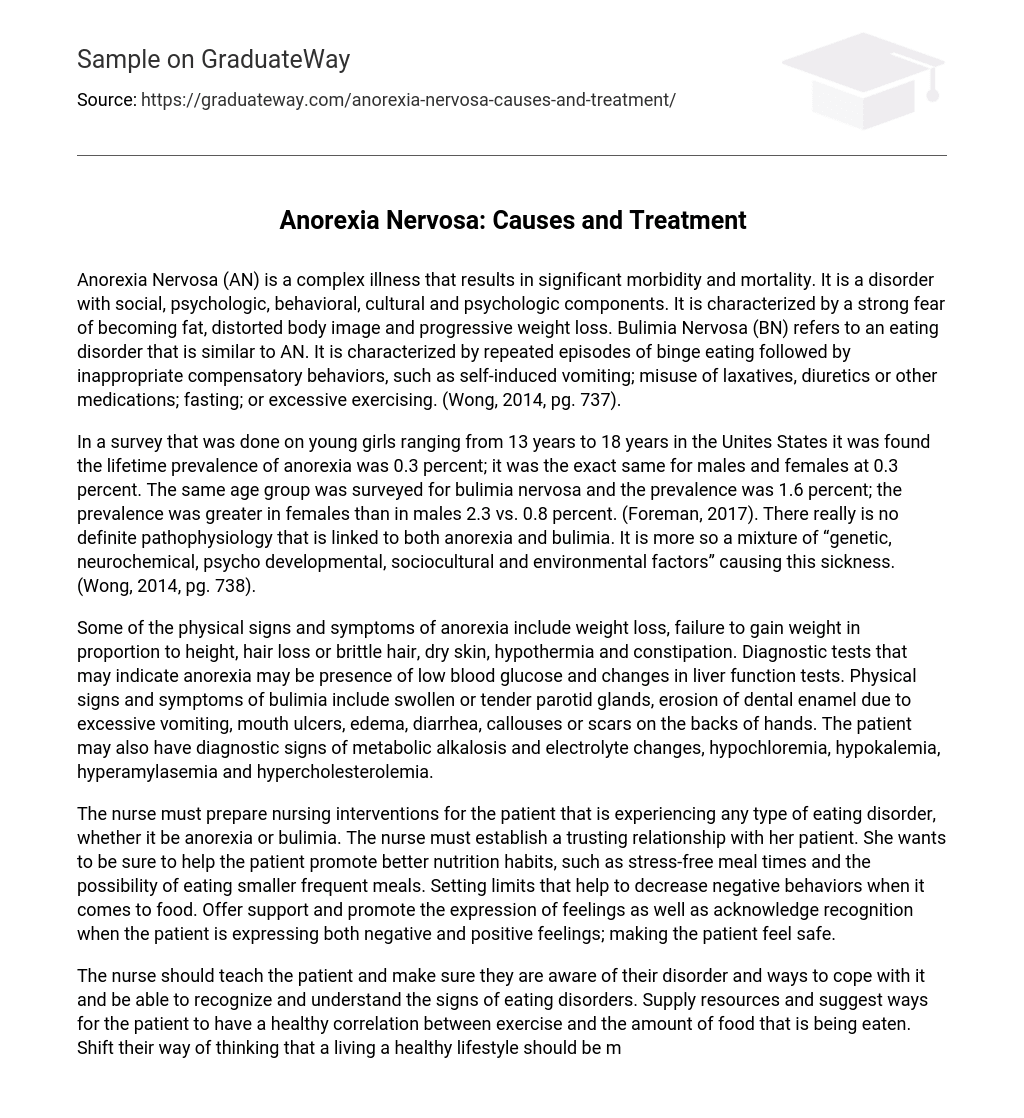Anorexia Nervosa (AN) is a complex illness that results in significant morbidity and mortality. It is a disorder with social, psychologic, behavioral, cultural and psychologic components. It is characterized by a strong fear of becoming fat, distorted body image and progressive weight loss. Bulimia Nervosa (BN) refers to an eating disorder that is similar to AN. It is characterized by repeated episodes of binge eating followed by inappropriate compensatory behaviors, such as self-induced vomiting; misuse of laxatives, diuretics or other medications; fasting; or excessive exercising. (Wong, 2014, pg. 737).
In a survey that was done on young girls ranging from 13 years to 18 years in the Unites States it was found the lifetime prevalence of anorexia was 0.3 percent; it was the exact same for males and females at 0.3 percent. The same age group was surveyed for bulimia nervosa and the prevalence was 1.6 percent; the prevalence was greater in females than in males 2.3 vs. 0.8 percent. (Foreman, 2017). There really is no definite pathophysiology that is linked to both anorexia and bulimia. It is more so a mixture of “genetic, neurochemical, psycho developmental, sociocultural and environmental factors” causing this sickness. (Wong, 2014, pg. 738).
Some of the physical signs and symptoms of anorexia include weight loss, failure to gain weight in proportion to height, hair loss or brittle hair, dry skin, hypothermia and constipation. Diagnostic tests that may indicate anorexia may be presence of low blood glucose and changes in liver function tests. Physical signs and symptoms of bulimia include swollen or tender parotid glands, erosion of dental enamel due to excessive vomiting, mouth ulcers, edema, diarrhea, callouses or scars on the backs of hands. The patient may also have diagnostic signs of metabolic alkalosis and electrolyte changes, hypochloremia, hypokalemia, hyperamylasemia and hypercholesterolemia.
The nurse must prepare nursing interventions for the patient that is experiencing any type of eating disorder, whether it be anorexia or bulimia. The nurse must establish a trusting relationship with her patient. She wants to be sure to help the patient promote better nutrition habits, such as stress-free meal times and the possibility of eating smaller frequent meals. Setting limits that help to decrease negative behaviors when it comes to food. Offer support and promote the expression of feelings as well as acknowledge recognition when the patient is expressing both negative and positive feelings; making the patient feel safe.
The nurse should teach the patient and make sure they are aware of their disorder and ways to cope with it and be able to recognize and understand the signs of eating disorders. Supply resources and suggest ways for the patient to have a healthy correlation between exercise and the amount of food that is being eaten. Shift their way of thinking that a living a healthy lifestyle should be more significant than physical appearance.
One of the Pediatricians at the Henry Ford Medical Center in Troy who has treated many patients with AN and BN both inpatient and outpatient was asked the treatment plan that she recommends for patients that she has treated with eating disorders. Her response was that she would refer them to Behavioral Health (BH) where they would help the patient to restore distorted body image, counseling and provide the patient with a minimum number of calories. If the patient was really skinny, she would not restrict calories; If they were bulimic, she would have a healthy calorie limit set for the patient. She says that during the times that she has treated patients with eating disorders, collaboration with BH, dieticians and if deemed necessary, hospitalization if the eating disorder is bad enough. (D. Stabel, DO, personal interview, September 24, 2018).
She goes on to saying that if refeeding is a serious complication and hospitalization is a required so the patient can be monitored. “Refeeding syndrome is a potentially fatal condition characterized by shifts in fluids and electrolytes that can occur in severely malnourished patients upon the reinstitution of nourishment orally, enterally, or parenterally.” (Marcel, 2018). Another serious complication she mentioned was cardiac dysrhythmias. “Cardiac arrest due to prolonged QT interval and electrolyte disturbances has been documented among patients with AN. These prolonged QT intervals may be secondary to hypokalemia, hypomagnesemia, hypophosphatemia or underlying prolonged QT syndrome. Life-threatening torsade de point may develop.” (Monge, 2018).
She was asked if there were there any associated psychiatric disorders, in her opinion, that would need to be treated. She answered that she believes that anxiety, depression and body dysmorphic disorder play a role in a patient with eating disorders. She also feels that it is important for family members to help play a role in the treatment process by parents monitoring for inappropriate purging behaviors, monitoring calories and exercise and to help their adolescent to follow a diet/exercise plan and to help promote good body image. (D. Stabel, DO, personal interview, September 24, 2018).
Assessment findings a nurse may observe if a patient were to develop refeeding syndrome would be fatigue, weakness, confusion, inability to breathe, seizures and heart arrhythmias. Assessment findings for cardiac dysrhythmias would be severe bradycardia and hypotension. Both of these require immediate attention.
Reference
- Foreman, S., MD (2017). Eating disorders: overview of epidemiology, clinical features and diagnosis. In J. Yager, MD (Ed.), UpToDate. Retrieved September 22, 2018 from https://www.uptodate.com/contents/eating-disorders-overview-of-epidemiology-clinical-features-and-diagnosis?search=eating-disorders-overview-of-epidemology-clinical-features-and-diagnosis&source=search_result&selectedTitle=1~150&usage_type=default&display_rank=1
- Hockenberry, Marilyn, David Wilson. Wong’s Nursing Care of Infants and Children, 10th Edition. Mosby, 09/2014. VitalBook file.
- Marcel, C. B., & March, P. P. (2018). Refeeding Syndrome. CINAHL Nursing Guide. Retrieved from https://chamberlainuniversity.idm.oclc.org/login?url=https://search.ebscohost.com/login.aspx?direct=true&db=nup&AN=T702781&site=eds-live&scope=site
- Monge, M. C., & Loh, M. (2018). Medical complications of eating disorders in pediatric patients. Pediatric Annals, 47(6), 238-243. doi:http://dx.doi.org.chamberlainuniversity.idm.oclc.org/10.3928/19382359-20180518-01





